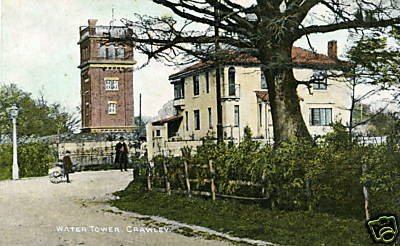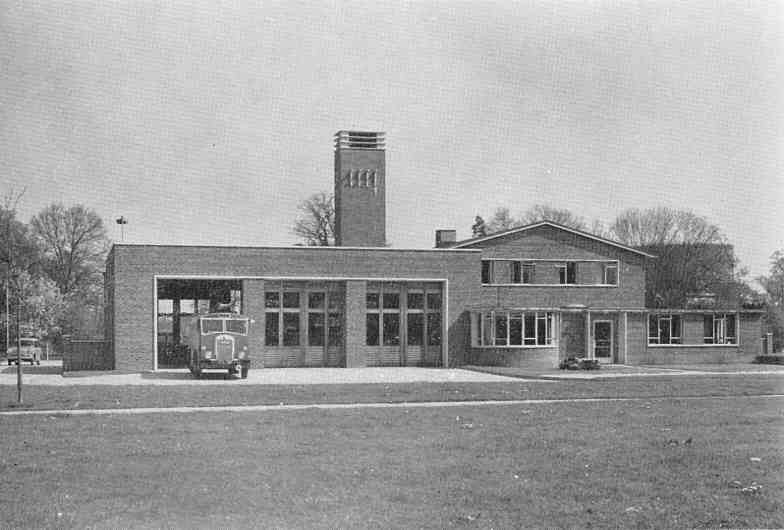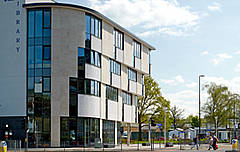

Crawley Gas Company raised capital mostly from local investment to supply street and house lighting, and was registered on 29th October 1858. A gas house was built to the north of Blackdog Lane. However, the Horley District Gas Company was empowered by the Horley Gas Act of 1901 to provide gas in Crawley, Ifield and Worth. The Crawley Company was underfinanced, going into liquidation in 1901 and was taken over by the Horley company in 1902. The gasworks at Crawley became disused by 1910 and gas was brought in by the new company.
Sources & Further Reading
Horley District Gas Act 1 Edw. 7 c.xx 1901
Crawley Victorian New Town, John Lowerson, 1980
Wayfarer Denman's Crawley Revisited, Nadine Hygate (1993), p. 25
Crawley & District Water Company - Goff's Park Road

Crawley & District Water Company was established by a private Act of Parliament in 1898. The Chairman was James Longley. Although water had been expected at a depth of 250 feet, due to a geological fault the borehole had to be sunk to 770 feet or more. The supply of water started in 1897-1898; by 1910 three quarters of the district was served by the company. However, at times breakdowns required assistance from the East Surrey Water Company. In 1925 the company was taken over by Horsham and East Grinstead Rural District Councils. The water tower and resovoir were built at Goff's Hill, the water tower has since been demolished.
Sources & Further ReadingCrawley and District Water Act 61 & 62 Vict. c.cxxiiii 1898
Crawley Victorian New Town, John Lowerson, 1980
Crawley and District Water Company, Charles J. Longley and Peter Longley, Sussex Industrial History, No. 32, 2002
Crawley Fire Brigade

Mark Lemon, amongst others, was responsible for the founding of Crawley Fire Brigade. He chaired a meeting, held in the Station Inn's Assembly Rooms, in August 1866 to raise funds and inaugurate the brigade. Thomas Bonsfield arranged for a second-hand engine, which was built in 1774, to be sent from London as a gift. The Brigade was a voluntary organisation until 1932. In 1922 they bought a motor pump and in 1926 a motor fire engine.
Horley District Gas Company - 2 High Street Woolborough Road
Horley District Gas Company was formed in 1862. In 1901 it was empowered by the Horley Gas Act of 1901 to provide gas in Crawley, Ifield and Worth. The Crawley Gas Company was underfinanced, going into liquidation in 1901 and was taken over by the Horley company in 1902.
Libraries


During the first half of the 20th century commercial Circulating libraries lent books for a fee. Libraries in Crawley included WT Dean, EF Hobley, AG Kale and Crawley & Ifield Co-operative Society.
Council run libraries were opened from the 1920s, with a branch in Crawley in Robinson Road School, later moving to Crowe Place in 1951. Temporary libraries were also opened in the New Town neighbourhoods. The library moved in 1954 to the Baptist Church Hall and again in 1960 to the old Post Office in the High Street. The neighbourhood libraries were replaced by two mobile libraries.
A purpose built library in County Buildings, Northgate Avenue, opened on 8th July 1963. Construction of the current library started in 2007 and it was opened on 16th December 2008.
Police
Before a police force was established the Vestry Committee formed a Prosecuting Society of respected men, who apprehended offenders and brought before the Manor Court.
Later, Crawley had two policemen: as Crawley was divided between Worth and Ifield Parishes both East Grinstead and Horsham were responsible for policing. Crawley's first police station was in Station Road, which was also were the town's policeman lived. A police station was built as part of County Buildings for Crawley New Town, subsequently moving to a new building in Northgate Avenue in the late 1990s. Gatwick Airport also has it's own police station.
Sources & Further ReadingSussex Police Forces: A Pictorial History from 1836 to 1986 (Middleton Press, 1987)
Wayfarer Denman's Crawley Revisited, Nadine Hygate (1993), pp.25-26
Crawley Observer, 15th July 1987
Sewage Works - London Road
South Eastern Electricity Board. - 55 High Street
South Eastern Gas Board - 2 High Street
Sussex Electricity Supply Co. - 27 High Street; 55 High Street; 2 Princess Road
Workhouses
A workhouse was built in 1747 on the west side of Ifield Green, and is now called Tweed Cottage. Worth Workhouse was a three-story cottage built in the 1790s and which stood on the corner of Church Road and Turners Hill Road. After forty years it was used as labourers' cottages by the Crabbett estate. Known as Khyber Cottages, they were demolished in the 1950s. Another former workhouse was in a late 17th-century building which stands near the roundabout where London Road, the A23 and M23 link roads meet. It later reverted to a row of cottages and is now a single house called Fir Tree Cottage.